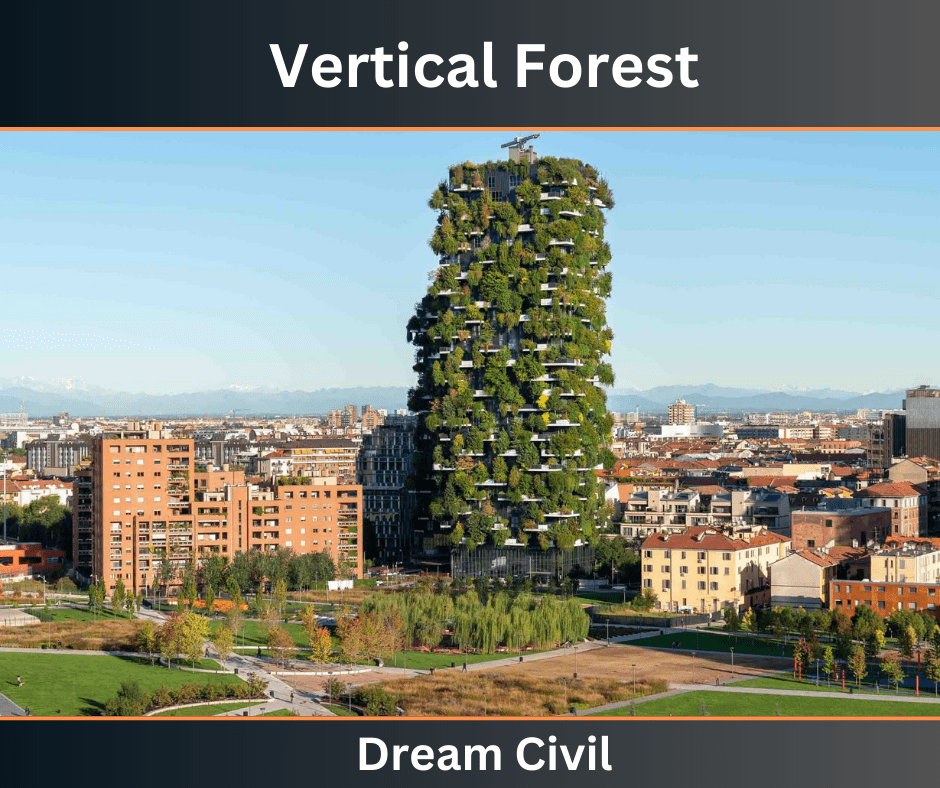Table of Contents
With increasing urbanization; the deforestation rate is also increasing at an immense rate because of land utilization to construct buildings or structures.
To tackle such a problem; the concept of vertical densification of vegetation on a building was introduced and named as a vertical forest.

If the exterior (sides & top) and vacant parts of the building are covered with vegetation then the building as a whole is considered as a vertical forest.
During the construction of the building; balcony-like projections are created to plant trees that serve both as a balcony and a small forest.
Already constructed buildings also can be converted into vertical forests.
Small to large plants can be used in vertical forests based on space available and requirements. Fruit plants are also given priority to get multiple benefits.
Construction of vertical forests is challenging itself because we have to focus on multiple factors like:
a. Leakage prevention
b. Plant and its root growth control
c. Loads control
d. Suitable plant selection
2. Construction of Vertical Forest
a. Construction of New Vertical Forest
1. Before starting the construction work, the following should be detailly analyzed:
a. Loads exerted by plants, soil, and structure itself.
b. Planning should be done to avoid possible future leakages.
2. Balcony-like projections should be constructed in the building such that they are capable to withstand high loads and also cover more than 10 % of the total floor area ( built-up area).
3. Before placing soil and planting trees; waterproofing membranes, drainage layers, and root barriers should be installed carefully as in green roof construction.
4. Top of the vertical forest is generally converted into an intensive green roof.
5. Plants should be selected carefully. For vertical, climbing plants are suitable and for horizontal, fruit plants and other medium-size trees are suitable.
b. Conversion of Existed Building
Load analysis in the existed building should be done and a safe load should be calculated which the building can bear.
Then waterproofing, installation of root barriers, etc should be done.
Based on the strength and capacity of the building; the top is converted into an extensive or intensive green roof.
Then for vertical densification; climbing plants are planted and vacant spaces (like surplus areas in balconies) are covered with trees.
Generally; small plants and trees are used.
3. Advantages
a. Rich in aesthetic beauty.
b. Increase in biodiversity.
c. Improve health and well-being.
d. Improvement in air quality.
e. Reduction in ambient temperature.
4. Disadvantages
a. Requirement of irrigation and maintenance.
b. Imposes loads on the structure.
c. Expensive to construct.
d. Chance of leakage if not constructed properly.
5. Example

Bosco Verticale is the first vertical forest( that consists of two residential towers) which is located in the Porta Nuova district of Milan, Italy, between Via Gaetano de Castillia and Via Federico Confalonier. The taller tower has a height of 110 m and the shorter one has 76 m.
This vertical forest is hosting 900 trees (each measuring 3, 6, or 9 meters) and over 20,000 plants.
6. References1. Content Filter & Authenticity Checking Team, Dream Civil International (Our team checks every content & detail to maintain quality.) |
Read Also: Green Roof

